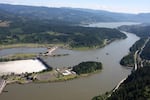The Pacific Northwest could see a slight increase in hydropower generation within the next 15 years, but climate change could affect how and when that energy could be used, a new study suggests.
The Pacific Northwest National Laboratory found hydropower generation, a renewable energy resource that uses the force of moving water to generate power, could increase by 5% by 2039 and 10% by 2059 throughout the United States.

The Bonneville Dam marks the beginning of the lower Columbia River. Federal researchers say hydroelectric power in the Pacific Northwest will increase slightly in the years to come.
Amelia Templeton
Only the Southwest is expected to see an average decrease in hydropower in that time frame due to drought.
Oregon and Washington saw a 20% drop in production in 2023 compared to 2021, the lowest in two decades.
But in looking further into the future, federal researchers gathered data from more than 1,400 hydropower facilities and compared it with data that showed how an increase in global temperatures could impact water flow and volume. PNNL’s data showed as the planet continues to warm, the increase in seasonal precipitation gives a slight boost to hydropower generation.
But the projected increases could be thwarted by the uncertainty of climate change and other extreme weather events. Researchers say by providing nationwide data, dam operators and utilities can better plan when, and how to use hydropower.
“We know the climate is changing and we know that’ll affect how much water will be available to produce hydropower,” Pacific Northwest National Laboratory hydro-climatologist and the study’s lead author Daniel Broman said in a statement. “Our research provides a consistent look across the country, so even if water and energy planners are only looking ahead regionally, our data can provide a broader outlook.”
As temperatures continue to rise due to the burning of fossil fuels, researchers looked into how climate change could impact a renewable energy source that’s been used for decades to power homes as well as provide flood control and ample water supply. It’s an energy source that could see a boost in production as the nation shifts away from its dependence on fossil fuels in order to reduce greenhouse gas emissions.
In the Pacific Northwest, hydropower provides 60% of the region’s energy, according to the study.
In Oregon, hydropower made up nearly 40% of the state’s electricity mix in 2021, as the Cascades provides plenty of snowmelt that flows into the nearby rivers.
But higher temperatures could change how much rain or snowmelt the region has, and it could create situations in which utilities need to adjust when to use hydropower, Nathalie Voisin, PNNL’s chief regional water energy dynamics researcher, said.
“The fact that the temperature is going to be higher, it means that the water, instead of being stored as the snowpack, it’s going to melt earlier,” she said.
Climate change could increase rainfall during the winter and spring months — contributing to water flow and increasing the amount of energy hydropower can produce, according to Voisin.
But during the summer and fall months, higher temperatures are expected to reduce the depth of mountain snowpack. And that means less water available for hydropower, she said.
Those changes could be challenging for water managers and utilities as they face a growing demand for more renewable energy production, Voisin said.
“Hydropower cannot generate the electricity that is needed,” Voison said, noting that drought could affect how much renewable energy can be produced by hydropower, especially as a constant “baseload” resource. But because of hydropower’s flexibility, it can “ramp up” production when renewable energy sources like wind and solar are not producing enough energy.
Using hydropower as a battery storage source or back up energy is also essential, Voisin said. Efforts are already underway in the Northwest to use what’s called “pumped storage” to make hydropower more flexible. Doing so helps the utilities to further balance variable sources like wind and solar, she said.
Overall, Voisin says hydropower is still a reliable source of renewable energy especially when paired with other renewable energy resources. But she says using hydro into the future could require better coordination, and potentially connecting power grids regionally to meet demands.
“Right now those utilities are looking at what they need to build or how they need to work with other regions,” she said. “... Instead of building everything local, there’s also a lot of regional coordination and so the utilities right now are trying to see what is going to be the mix of technology that they need or coordination so that they can meet this electricity demand.”


